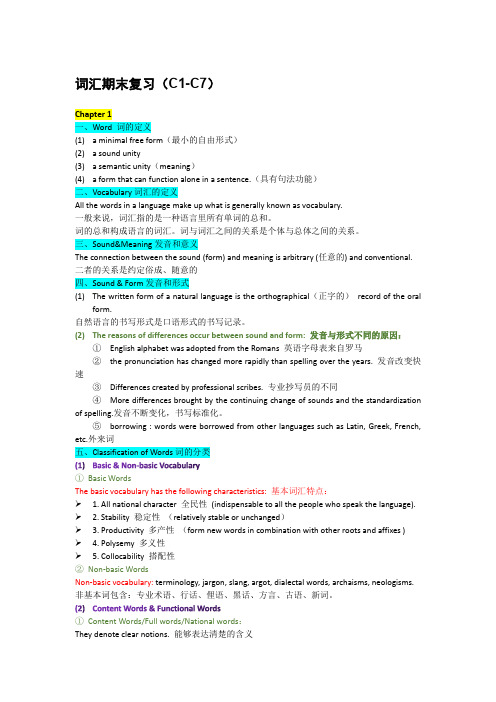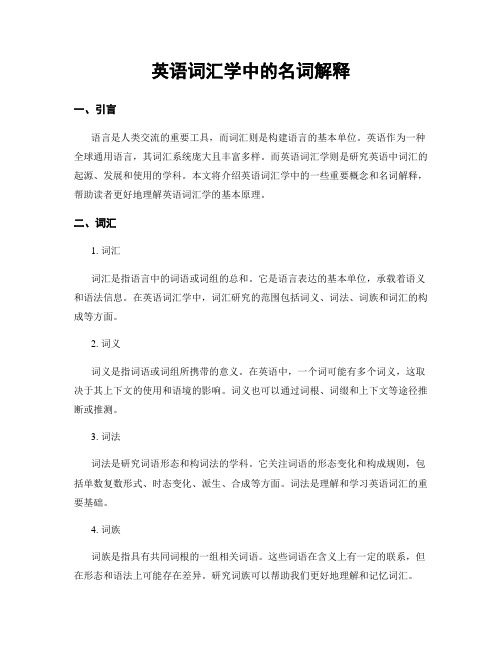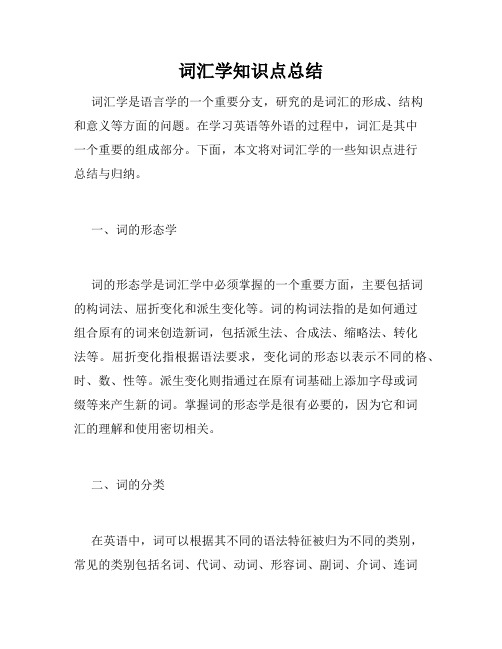英语词汇学基本概念汇总
英语词汇学知识点整理

词汇期末复习(C1-C7)Chapter 1一、Word 词的定义(1) a minimal free form(最小的自由形式)(2) a sound unity(3) a semantic unity(meaning)(4) a form that can function alone in a sentence.(具有句法功能)二、Vocabulary词汇的定义All the words in a language make up what is generally known as vocabulary.一般来说,词汇指的是一种语言里所有单词的总和。
词的总和构成语言的词汇。
词与词汇之间的关系是个体与总体之间的关系。
三、Sound&Meaning发音和意义The connection between the sound (form) and meaning is arbitrary (任意的) and conventional. 二者的关系是约定俗成、随意的四、Sound & Form发音和形式(1)The written form of a natural language is the orthographical(正字的)record of the oralform.自然语言的书写形式是口语形式的书写记录。
(2)The reasons of differences occur between sound and form: 发音与形式不同的原因:①English alphabet was adopted from the Romans 英语字母表来自罗马②the pronunciation has changed more rapidly than spelling over the years. 发音改变快速③Differences created by professional scribes. 专业抄写员的不同④More differences brought by the continuing change of sounds and the standardization of spelling.发音不断变化,书写标准化。
英语词汇学复习大纲整理

1 B a s i c C o n c e p t s 基本概念1.1 the definition of a word(: (1) a minimal free form of a language ; (2) a sound unity ; (3) a unit of meaning; (4) a form that can function alone in a sentence. A word is a minimal free form of a language that has a given sound and meaning and syntactic function 。
)1.2 sound and meaning :symbolic connection is almost always arbitrary and conventional 。
A dog is called a dog not because the sound and the three letters that make up the word just automatically suggest the animal in question.1.3 sound and form : 1.4 vocabulary 1.5 classification of words 词汇分类 basic word stock 基本词汇nonbasic vocabulary非基本词汇 by use frequency 按使用频率分: basic word stock and nonbasic vocabulary 基本词汇和非基本词汇by notion 按概念分:content words and functional words实义词和功能词by origin 按起源分: native words and borrowed words 本地词和外来词 all national character 全民性stability 稳定性 productivity 多产性 polysemy 一词多义 collocability 搭配性terminology 术语jargon 行话slang 俚语argon 黑话dialectal words 方言词archaism 古语词neologism 新词neutral in style 文体上中性frequent in use 使用频繁native words本地词 borrowed words 外来词 denizens 同化词aliens 异形词translation-loans 译借词1. No enough letters: alphabet from Latin2. Pronunciation changed more rapidly3. Early scribes: change spelling for easier recognition4. Borrowing: different rules of pronunciation and spelling obviouscharacteristics明显的特点(Functional words do not have notions of their own and their main function is to express the relation betweennotions, words, etc.)2D e v e l o p m e n tIt is assumed that the world has approximately 3, 000 (some put it 5, 000 ) languages, which can be grouped into roughly 300 language families on the basis of similarities in their basic word stock and grammar。
英语词汇学中的名词解释

英语词汇学中的名词解释一、引言语言是人类交流的重要工具,而词汇则是构建语言的基本单位。
英语作为一种全球通用语言,其词汇系统庞大且丰富多样。
而英语词汇学则是研究英语中词汇的起源、发展和使用的学科。
本文将介绍英语词汇学中的一些重要概念和名词解释,帮助读者更好地理解英语词汇学的基本原理。
二、词汇1. 词汇词汇是指语言中的词语或词组的总和。
它是语言表达的基本单位,承载着语义和语法信息。
在英语词汇学中,词汇研究的范围包括词义、词法、词族和词汇的构成等方面。
2. 词义词义是指词语或词组所携带的意义。
在英语中,一个词可能有多个词义,这取决于其上下文的使用和语境的影响。
词义也可以通过词根、词缀和上下文等途径推断或推测。
3. 词法词法是研究词语形态和构词法的学科。
它关注词语的形态变化和构成规则,包括单数复数形式、时态变化、派生、合成等方面。
词法是理解和学习英语词汇的重要基础。
4. 词族词族是指具有共同词根的一组相关词语。
这些词语在含义上有一定的联系,但在形态和语法上可能存在差异。
研究词族可以帮助我们更好地理解和记忆词汇。
5. 词汇构成词汇构成是指由词根、词缀和其他语法成分组合而成的词语。
在英语中,许多词汇都是通过加上前缀、后缀或派生词缀来构建的。
研究词汇构成可以帮助我们学习和运用更多的词汇。
三、语义1. 语义语义是研究语言意义的学科。
它关注语言符号和所表示的意义之间的关系,包括词语、句子和篇章的意义。
在英语词汇学中,研究语义可以帮助我们理解和区分词语之间的差异。
2. 同义词同义词是指在特定语境下具有类似或相同意义的词语。
在英语中,同义词的选择可以丰富语言的表达,同时也对理解和翻译起到重要作用。
3. 反义词反义词是指在意义上相对对立或相互排斥的词语。
它们可以用来表达相反的概念或情感。
在英语中,反义词常常通过前缀、后缀或词根的变化来形成。
4. 上位词与下位词上位词是指泛指概念的词语,下位词则是指具体的概念。
例如,动物是"猫"的上位词,而"猫"是动物的下位词。
词汇学基本理论

词汇学基本理论词汇学基本理论一、词的定义词是语音、意义和语法特点三者统一的整体。
二、词的语音和意义1、派别1)自然派:认为音和义之间存在着必然的联系。
2)习惯派:认为音和义之间没有必然的联系。
如:meat(肉)汉语(ròu)法语(viande)意大利语(carne)瑞典语(kott)sight(视力)site(场所)cite(引证)三、词的词汇意义和语法意义语法意义不同,往往会引起词汇意义的一些改变、如:He tore down the hill.Three enemy plans were downed yesterday.有些词只适合在特定的语境(context)中使用,常常带有语体色彩。
如:But(v.)me no buts(n.). 别老找理由。
四、词与词汇1、关系:个体与总体的关系,词的总和构成语言的词汇2、词汇:不仅指语言中所有的词,还包括方言、使用域、术语等某一语言变体中使用的词和短语3、词汇的分类英语词汇目前共计约200多万,包括本族词(native words)和外来词(borrowed words),其中本族词为基本词汇,他们在语言中使用最多。
所以又被称为“高频词”。
外来词:拉丁语、丹麦语、法语、德语、意大利语、西班牙语、阿拉伯语、日语等。
五、词的组成单位——形位(又称为:词素)1、形位的概念:是最小的语法单位,也是最小的语义单位。
2、类型:词是由形位构成的,有的词只有一个形位,如log, clerk solider等,有的词有多个形位,如lovely有love 和ly 两个形位,unfriendly有un,friend,ly 三个形位。
六、实义形位、语法形位1)实义形位:构成词的语义基础,可以单独使用,有独立的意义,所以又称为自由形位或自由词素。
这种形位相当于词根(root)如:teacher中的teach 2)语法形位:只表示附加意义或语法意义,必须依附于其他形位与之结合才能使用,所以,又被称之为“粘附形位”或“粘附词素”。
英语词汇学知识点归纳总结

英语词汇学知识点归纳总结
1.词汇分类:英语词汇可以分为实词和虚词两大类。
实词包括名词、
动词、形容词和副词,是能独立存在并具有词义的词类;虚词包括冠词、
介词、连词、代词和助词,是不能独立存在或不具有词义的词类。
2.词根与词缀:英语词汇中有很多词根和词缀,词根是词的核心部分,词缀是附加在词根上的,可以改变词的词义、词性或词形。
3.词义:英语词汇的词义可以通过定义、同义词、反义词、上下义词
等方式进行描述和解释。
词义可以有直观意义、引申意义和隐喻意义等。
4.词汇建构:英语词汇的建构可以通过合成、派生、转化、缩略等方
式进行。
合成是通过将两个或多个词根组合成一个新词,派生是通过添加
前缀或后缀来构成新词,转化是通过改变词的词类来构成新词,缩略是通
过省略部分词组或词根来构成新词。
5.词汇变化:英语词汇的变化形式包括时态、语态、人称、数和比较等。
词汇的变化形式可以通过词形变化、语法变化和语义变化等方式进行。
6.外借词:英语词汇中存在大量的外借词,这些词汇主要来自拉丁语、希腊语、法语、德语等其他语言。
外借词在英语中经过适当的拼写、读音
和意义调整后被接受和使用。
7.同源词:英语词汇中存在一些同源词,这些词源于同一词根或词源,并在语音、形态或词义上有一定的相似性。
了解同源词可以帮助理解和记
忆词汇。
8.词汇扩展:英语词汇在发展的过程中会发生扩展,即一个词从最初的特定意义扩展到更广泛的意义。
词汇扩展可以通过引申、转义、隐喻等方式进行。
这些是英语词汇学中的一些主要知识点,通过对这些知识点的学习和理解,可以更好地掌握和应用英语词汇。
词汇学知识点

词汇学知识点词汇学是语言学的一个重要分支,研究词汇的形态、构词法、含义、语法功能和使用规律等方面的知识。
词汇学知识点有助于我们更深入地了解语言的结构和规律,提高我们的语言运用能力和沟通能力。
下面将就词汇学的一些重要知识点进行详细介绍。
1. 词汇的分类根据词性的不同,词汇可以分为名词、动词、形容词、副词、代词、介词、连词和感叹词等不同种类。
名词是表示人、事、物、地点或抽象概念的词,如“学校”、“朋友”;动词是表示动作或状态的词,如“看”、“跑”;形容词是用来描述名词或代词的性质或特征的词,如“美丽”、“聪明”;副词是用来修饰动词、形容词或其他副词的词,如“很”、“非常”。
2. 词汇的构词法构词法是指词汇的构成规律和方法。
词汇可以通过加前缀、后缀、派生、复合、缩略、转化等方式形成新词。
比如,“美”+“丽”=“美丽”;“快”+“速”=“快速”;“快速”+“度”=“快速度”。
3. 词汇的含义词汇的含义是指词汇所代表的概念或事物。
词汇的含义可以根据词义的延伸、转义、比喻、象征等方式进行词义推论。
比如,“明星”原指天空中的星星,后引申为受人尊敬或崇拜的人。
4. 词汇的语法功能词汇在句子中具有不同的语法功能,如名词可以作主语、宾语、定语、表语等;动词可以表示主谓关系、宾语关系、状语关系等;形容词和副词可以修饰名词或代词等。
5. 词汇的使用规律词汇在语言运用中有一定的使用规律,比如词的搭配、语法环境、语言风格等。
正确地运用词汇有助于提高语言表达的准确性和丰富性。
通过以上对词汇学知识点的介绍,我们可以更系统地了解词汇在语言中的作用和重要性,进一步提高我们的语言水平和表达能力。
希望大家都能在学习词汇学知识点的过程中取得更好的成绩,展现自己在语言运用方面的能力。
【正文结束】。
词汇学知识点总结

词汇学知识点总结词汇学是语言学的一个重要分支,研究的是词汇的形成、结构和意义等方面的问题。
在学习英语等外语的过程中,词汇是其中一个重要的组成部分。
下面,本文将对词汇学的一些知识点进行总结与归纳。
一、词的形态学词的形态学是词汇学中必须掌握的一个重要方面,主要包括词的构词法、屈折变化和派生变化等。
词的构词法指的是如何通过组合原有的词来创造新词,包括派生法、合成法、缩略法、转化法等。
屈折变化指根据语法要求,变化词的形态以表示不同的格、时、数、性等。
派生变化则指通过在原有词基础上添加字母或词缀等来产生新的词。
掌握词的形态学是很有必要的,因为它和词汇的理解和使用密切相关。
二、词的分类在英语中,词可以根据其不同的语法特征被归为不同的类别,常见的类别包括名词、代词、动词、形容词、副词、介词、连词和感叹词等。
不同的词在句子中扮演着不同的角色,掌握各类别之间的区别以及它们在句子中的作用,可以帮助我们更好地理解和表达语言。
三、词义词义是从语言学的角度定义词的意义,包括原义和引申义。
原义指的是一个词最基本的意思,而引申义则是在原义基础上经过延伸、扩展而得到的新意义。
同一个词的不同意义和语言环境等也会导致其含义的变化,例如“bank”既可以表示银行,也可以表示河岸等。
在学习外语的过程中,掌握词义是十分重要的。
四、词汇的学习方法词汇的学习是英语学习中最基础也最重要的部分之一,因此选择适合自己的学习方法对于提高词汇量、扩大词汇面积至关重要。
常用的学习方法包括反复背诵、积累单词簿、整理词根词缀、阅读和听力等。
在学习方法上,以选择适合自己和有用的方法为主,同时注意与语言运用的联系,不断地推广和实践。
五、词汇的应用掌握了词汇学的知识和学习方法后,其实就迈出了学习英语的第一步。
在实际运用中,如何运用得当也是至关重要的环节。
为了提高语言的流利度,需要在口语和书面语两个方面加强实践,增强实际运用能力。
另外,可以较晚多在社交网络等平台上与外国人联系,使用所学的词汇,将知识应用到实际交流之中,效果更佳。
英语词汇学知识点整理

词汇期末复习(C1-C7)Chapter 1一、Word 词的定义(1) a minimal free form(最小的自由形式)(2) a sound unity(3) a semantic unity(meaning)(4) a form that can function alone in a sentence.(具有句法功能)二、Vocabulary词汇的定义All the words in a language make up what is generally known as vocabulary.一般来说,词汇指的是一种语言里所有单词的总和。
词的总和构成语言的词汇。
词与词汇之间的关系是个体与总体之间的关系。
三、Sound&Meaning发音和意义The connection between the sound (form) and meaning is arbitrary (任意的) and conventional. 二者的关系是约定俗成、随意的四、Sound & Form发音和形式(1)The written form of a natural language is the orthographical(正字的)record of the oralform.自然语言的书写形式是口语形式的书写记录。
(2)The reasons of differences occur between sound and form: 发音与形式不同的原因:①English alphabet was adopted from the Romans 英语字母表来自罗马②the pronunciation has changed more rapidly than spelling over the years. 发音改变快速③Differences created by professional scribes. 专业抄写员的不同④More differences brought by the continuing change of sounds and the standardization of spelling.发音不断变化,书写标准化。
- 1、下载文档前请自行甄别文档内容的完整性,平台不提供额外的编辑、内容补充、找答案等附加服务。
- 2、"仅部分预览"的文档,不可在线预览部分如存在完整性等问题,可反馈申请退款(可完整预览的文档不适用该条件!)。
- 3、如文档侵犯您的权益,请联系客服反馈,我们会尽快为您处理(人工客服工作时间:9:00-18:30)。
《英语词汇学》重要术语One:1. Native words 本族词 Words of Anglo-Saxon origin or of Old English are native words.2. Loan words 借词 Words borrowed from other languages are loan words or borrowed words.3. Slang words 俚语 Slang words are those words of a vigorous, colourful, facetious, or taboo nature, invented for specific occasions, or uses, or derived from the unconventional use of the standard vocabulary.4. Function words 功能词 Function words are often short words such as determiners, conjunctions, prepositions, auxiliaries that serve grammatically more than anything else.5. Content words 实义词 Content words are used to name objects, qualities, actions, processes or states, and have independent lexical meaning.6. Free forms 自由形式 Forms which occur as sentences are free forms.Two:1. Morphemes 语素 Morphemes are the smallest meaningful linguistic units of English language, not divisible or analyzable into smaller forms.2. Allomorphs 语素变体 Allomorphs are any of the variant forms of a morpheme as conditioned by position or adjoining sounds.3. Free morpheme 自由语素 Free morpheme is one that can be uttered alone with meaning.4. Bound morpheme 粘着语素 Bound morpheme cannot stand by itself as a complete utterance and must appear with at least one other morpheme, free or bound.5. Root 词根 Root is the basic unchangeable part of a word and it conveys the main lexical meaning of the word.6. Affix 词缀 Affix is a collective term for the type of formative that can be used only when added to another morpheme.7. Inflectional affix 屈折词缀 Inflectional affix serves to express such meanings as plurality, tense, and the comparative or superlative degree.8. Derivational affix 派生词缀 Derivational affix is the kind of affixes that hasspecific lexical meaning hand can derive a word when it is added to another morpheme.9. Prefixes 前缀 Prefixes are affixes added before words.10. Suffixes 后缀 Suffixes are affixes added after words.Three1. Word-formation rules 构词规则 Word-formation rules define the scope and methods whereby speakers of a language may create new words.2. Stem 词干 Stem is the part of the word-form which remains when all inflectional affixes have been removed.3. Base 词基 Base is any form to which affixes of any kind can be added.4. Compounding 合成法 Compounding is a word-formation process consisting of joining two or more bases to form a new unit.5. Derivation 派生法 Derivation or affixation is a word-formation process by which new words are created by adding a prefix, or suffix, or both, to the base.6. Conversion 转化法 Conversion is a word-formation process whereby a word of a certain word-class is shifted into a word of another word-class without the addition of an affix.7. Prefixation 前缀法 Prefixation is the addition of a prefix to the base.8. Suffixation 后缀法 Suffixation refers to the addition of a suffix to the base.Four:1. Initialism 首字母连写词 Initialism is a type of shortening, using the first letters of words to form a proper name, a technical term or a phrase and it is pronounced letter by letter.2. Acronyms首字母拼音词 Acronyms are word formed from the initial letters of the name of an organization or a scientific term, and they are pronounced as words rather than as sequences of letters.3. Clipping 截短法 The process of clipping involves the deletion of one or more syllables from a word (usually a noun), which is also available in its full form.4. Blending 拼缀法 Blending is a process of word-formation in which a new word is formed by combining the meanings and sounds of two words, one of which is not in its full form or both of which are not in their full forms.5. Back-formation 逆成法 Back-formation is a type of word-formation by which a shorter word is coined by the deletion of a supposed affix from a longer form already present in the language.6. Reduplication 重叠法 Reduplication is a minor type of word-formation by whicha compound word is created by therepetition of one word or of two almost identical words with a change in the vowels or of two almost identical words with a change in the initial consonants.7. Neoclassical formation 新古典词构成法 Neoclassical formation is the process by which new words are formed from elements derived from Latin and Greek.Five:1. Conventionality 约定俗成 It is the characteristics of relation between the sound-symbol and its sense: there is no way to explain why this or that sound-symbol has this or that meaning beyond the fact that the people of a given community have agreed to use one to designate the other.2. Motivation 理据 Motivation refers to the direct connection between word-symbol and its sense.3. Echoic/ onomatopoeic words 拟声词 Echoic words or onomatopoeic words are words motivated phonetically whose pronunciation suggests the meaning.4. Morphological motivation 语素结构理据 A word is morphologically motivated ifa direct connection can be observed between the morphemic structure of the word and its meaning.5. Semantic motivation 语义理据 Semantic motivation refers to motivation based on semantic factors and it is usually provided by the figurative usage of words.6. Grammatical meaning 语法意义 Grammatical meaning consists of word-class and inflectional paradigm.7. Inflectional paradigm 词形变化 The set of grammatical forms of a word is called its inflectional paradigm. Nouns are declined, verbs are conjugated and gradable adjectives have degrees of comparison.8. Denotative meaning 外延意义 The denotative meaning of a word is its definition given in a dictionary.9. Connotative meaning 内涵意义 Connotative meaning refers to the emotional association which a word or a phrase suggests in one’s mind.10. Social or stylistic meaning 社会意义 Social meaning is that which a piece oflanguage conveys about the social circumstances of its use.11. Affective meaning 情感意义 Affective meaning is concerned with the expression of feelings and attitudes of the speaker or writer.12. Componential analysis 语义成分分析 The conceptual meaning or denotative meaning can be broken down into its minimal distinctive components which are known as semantic features. Such an analysis is called componential analysis.Six:1. Polysemy 一词多义 Polysemy happens when more than one meaning is attached toa word.2. Radiation 词义辐射 Semantically, radiation is the process in which the primary or central meaning stands at the center while secondary meanings radiate from it in every direction like rays.3. Concatenation 语义的连锁、联结 Concatenation is a semantic process in which the meaning of a word moves gradually away from its first sense by successive shifts, like the links of a chain, until there is no connection between the sense that is finally developed and the primary meaning.4. Homonymy 同音异义、同形异义 Homonymy is the relation between pairs or groups of word which, though different in meaning, are pronounced alike, or spelled alike or both.5. Perfect homonyms 完全同音同形异义词 Words identical in sound and spelling but different in meaning are called perfect homonyms.6. Homophones 同音异义词 Words identical in sound but different in spelling and meaning are called homophones.7. Homographs 同形异义词Words identical in spelling but different in sound and meaning are called homographs.8. Phonetic convergence 音变的汇合 Phonetic convergence is the kind of phenomenon where two or more words which once were different in sound forms take on the same pronunciation.9. Semantic Divergence 词义分化 When two or more meanings of the same word drift apart to such an extent that there will be no obvious connection between them, the word has undergone the process of semantic divergence.Seven: 1. Synonyms 同义词 A synonym may be defined as a word having the same meaning as another word: as one of two or more words of the same language and grammatical category having the same essential or generic meaning and differing only in connotation, application, or idiomatic use. 2. Complete synonyms 完全同义词 Two words are totally synonymous only if they are fully identical in meaning andinterchangeable in any context without the slightest alteration in connotative, affective and stylistic meanings. 3. Relative synonyms 相对同义词Relative synonyms are words that are not fully identical but may differ in shades of meaning, in emotional colouring, in level of formality, in collocation, and in distribution.4. Antonymy 反义关系 In its general sense, antonymy refers to all types of semantic oppositeness.5. Contraries/gradable antonyms 相对性反义词Contraries or contrary terms display such a type of semantic contrast that they can be handled in terms of gradability, that is, in terms of degrees of the quality involved.6. Complementaries/contradictory terms 互补性反义词Complementaries or contradictories represent a type of binary semantic opposition so that theassertion of one of the items implies the denial of the other. 7. Conversives/converses/relational opposites 换位性反义词 Conversives represent such a type of binary semantic opposition that there is an interdependence of meaning, or say, one member of the pair presupposes the other. 8. Hyponymy 上下义关系Hyponymy is the relationship which obtains between specific and general lexical items, such that the former is included in the latter. 9. Superordinates 上义词 The general term in a hyponymy pair is called a superordinate linguistically. 10. Hyponyms 下义词 The specific term in a hyponymy pair is called the hyponym or subordinate. 11. Semantic field 语义场 Semantic field theory is concerned with the vocabulary of a language as a system of interrelated lexical networks. The words of a semantic field are joined together by a common concept, and they are likely to have a number of collocations in common. Eight: 1. Context 语境 Context in its narrowest sense consists of the lexical items that come immediately before and after any word in an act of communication. But, in broader sense, it may cover the whole passage and sometimes the whole book in which a word occurs, and in some cases even the entire social or cultural setting. 2. Linguistic context 语言语境Linguistic context is lexical, grammatical and verbal context in its broad sense.3. Extra-linguistic context 语言之外的环境 Extra-linguistic context refers not only to the actual speech situation in which a word is used but also to the entire cultural background against which a word, or an utterance or a speech event is set.4. Lexical context 词汇语境 Lexical context refers to the lexical items combined with a given polysemous word.5. Grammatical context 语法语境 In grammatical context, the syntactic structure of the context determines various individual meanings of a polysemous word.6. Verbal context 言语语境 The verbal context, in its broadest sense, may cover an entire passage, or even an entire book, and in some cases even the entire social or cultural setting.7. Ambiguity 歧义 Ambiguity refers to a word, phrase, sentence or group of sentences with more than one possible interpretation or meaning.8. Lexical ambiguity 词汇歧义 Lexical ambiguity is caused by polysemy.9. Structural ambiguity 结构歧义 Structural ambiguity arises from the grammatical analysis of a sentence or a phrase.Nine: 1. Change of word meaning 语义变化 When a word loses its old meaning and comes to refer to something altogether different, the result is a change of word meaning. Broadly speaking, change of meaning refers to the alteration of the meaning of existing words as well as the addition of new meaning to establish words. 2. Restriction of meaning 语义专门化 Restriction of meaning or specialization of meaning means that a word of wide meaning acquires a narrower, specialized sense which is applicable to only one of the objects it had previously denoted. 3. Extension of meaning 词义扩展化 Extension of meaning or generalization means the widening of a word’s sense until it covers much more than what it originally conveyed.4. Degeneration of meaning 词义降格 There are two main forms of degeneration or pejoration. One refers to the process where words once respectable or neutral may shift to a less respectable, or even derogatory meaning. The other refers to the weakening of meaning resulting from habitual use of particular words on unsuitableoccasions. 5. Elevation of meaning 词义升格 It refers to the process that the meaning of a word goes uphill. 6. Metaphor 暗喻 Metaphor is a figure of speech containing an implied comparison based on association of similarity, in which a word or a phrase ordinarily and primarily used for one thing is applied to another. 7. Metonymy 转喻 It is a figure of speech by which an object or idea is described by the name of something closely related to it. Ten: 1. Idiom 习语 An English idiom is a group of words with a special meaning different from the meanings of its constituent words. It is a combination of two or more words which are usually structurally fixed and semantically opaque, and function as a single unit of meaning.2. Phrase idioms 惯用短语 All phrase idioms have a noun, verb, adjective, preposition or an adverb as the central word and correspond to the familiar parts of speech, and are capable of a given syntactic function. 3. Clause idioms 从句成语Clause idioms or subject-less clause patterns contain objects and / or complements. 4. Sentence idioms 句子成语 The two major types of sentence idioms are proverbs or sayings and typical conversational expressions. 5. Proverbs 谚语 Proverbs are sentences accepted by the people and handed down to the present day because they express some obvious truth or familiar experience in a concise and witty style.(注:文档可能无法思考全面,请浏览后下载,供参考。
